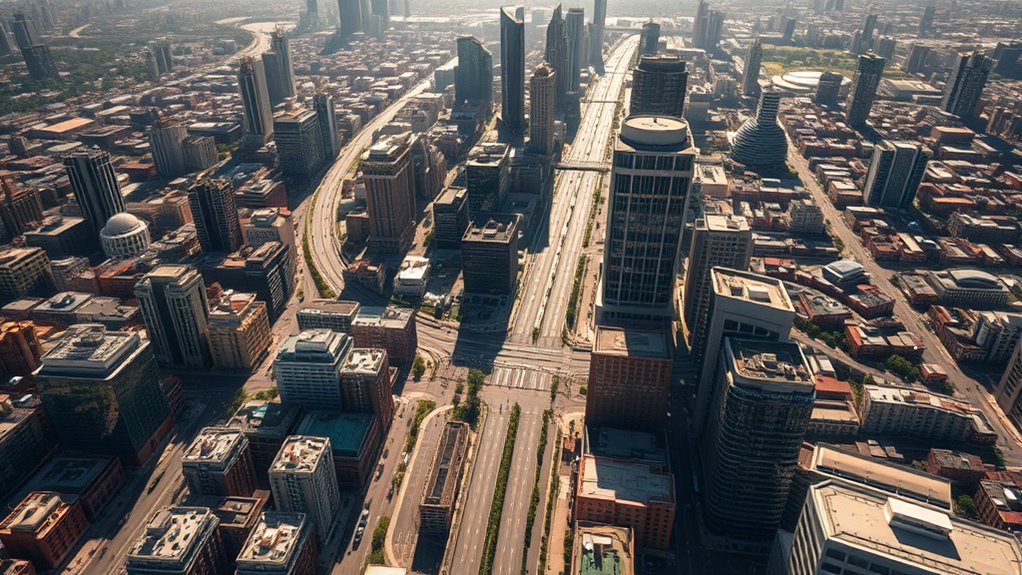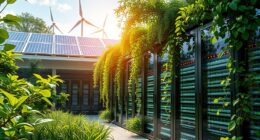Cities feel hotter than the forecast because of the urban heat island effect. Your city’s buildings, roads, and pavement absorb and trap heat during the day, then release it slowly at night. Limited greenery and dense infrastructure block airflow, making it even worse. As a result, temperatures can be several degrees higher than nearby rural areas. To better understand how urban planning and different strategies help combat this, keep exploring.
Key Takeaways
- Cities retain more heat due to materials like concrete and asphalt that absorb and slowly release warmth.
- Tall buildings and dense infrastructure limit airflow, trapping heat near ground level.
- Reduced green spaces and vegetation decrease natural cooling through shade and evapotranspiration.
- Reflective surfaces and heat-absorbing materials increase surface temperatures compared to rural areas.
- Urban design and microclimates create localized hotspots, making cities feel hotter than forecasted temperatures.

Have you ever noticed that cities often feel noticeably warmer than surrounding rural areas? This phenomenon, known as the urban heat island effect, happens because urban environments tend to retain heat more than natural landscapes. When you walk through a city on a hot day, the temperature can be several degrees higher than nearby countryside. This isn’t just a minor discomfort—it impacts your health, energy bills, and overall quality of life. Understanding why this happens can help you see how urban planning plays a essential role in climate adaptation strategies aimed at reducing these heat disparities.
Cities often feel warmer than rural areas due to the urban heat island effect.
Urban planning influences how cities manage their heat. Concrete, asphalt, and other building materials used in cities absorb and store heat during the day, releasing it slowly at night. Tall buildings and dense infrastructure limit airflow, trapping heat close to the ground. This creates a microclimate that’s consistently warmer than rural areas. Recognizing these factors, city planners are increasingly incorporating climate adaptation measures, such as green roofs, reflective surfaces, and increased tree coverage, to combat the heat island effect. These strategies not only cool down the environment but also improve air quality and provide shade, making urban spaces more livable.
You can also see how urban planning directly affects your daily experience. For example, neighborhoods with more parks and trees tend to stay cooler because vegetation provides shade and cools the air through evapotranspiration. Wide streets with reflective pavements can bounce sunlight away, reducing heat absorption. Implementing such climate adaptation techniques requires thoughtful design and policy support, but the payoff is significant. When cities prioritize these approaches, they create healthier, more resilient environments that can withstand heatwaves and rising temperatures due to climate change.
Furthermore, your city’s infrastructure choices influence how effectively it adapts to a warmer climate. Incorporating green spaces, promoting sustainable building materials, and enhancing public transit can reduce overall heat retention and decrease energy demand for cooling. Additionally, increasing the use of permeable surfaces helps manage stormwater runoff and reduces heat absorption. These efforts also help mitigate the urban heat island effect over time, making your city less susceptible to extreme temperature spikes. As a resident, it’s empowering to know that urban planning isn’t just about aesthetics or convenience; it’s a essential tool for climate adaptation that directly impacts your comfort and safety.
Frequently Asked Questions
How Does Urban Heat Affect Local Wildlife?
Urban heat affects local wildlife by disrupting their habitats and behaviors. You might notice urban wildlife struggling to find food or water as higher temperatures alter ecosystems. These temperature increases can cause stress, reduce reproductive success, and shift migration patterns. As a result, urban heat impacts ecosystem health, threatening biodiversity and changing the delicate balance of urban wildlife populations, making it harder for these creatures to thrive in city environments.
What Cities Are Most Impacted by Heat Islands?
You’ll notice that cities like New York, Los Angeles, and Chicago are most impacted by heat islands. These urban areas often lack pavement cooling options and green roofs, which can help mitigate heat. Without these features, the city’s concrete and asphalt absorb more heat, making it feel hotter. Installing green roofs and implementing pavement cooling strategies can markedly reduce the urban heat island effect and make your city more comfortable.
Can Urban Planning Reduce Urban Heat Effects?
You can reduce urban heat effects through smart planning. Incorporate green roofs to provide natural cooling and absorb heat, and use reflective pavements that bounce sunlight away instead of trapping it. These strategies lower temperatures, improve air quality, and create more comfortable urban environments. By adopting these measures, your city becomes more resilient to heat, making summer days cooler and more livable for everyone.
How Do Heat Islands Influence Energy Consumption?
Heat islands increase your city’s temperature, making cooling more necessary. This leads to higher energy consumption as you rely more on air conditioning and cooling technology. To cut energy use, you can adopt energy-saving strategies like planting trees and reflective roofs. These measures help reduce heat, lower cooling needs, and save you money. Implementing such strategies not only benefits your comfort but also diminishes your environmental impact.
Are There Health Risks Linked to Urban Heat?
Imagine the city as a sizzling oven, where rising temperatures can threaten your health. You face risks like heat-related illnesses and worsening air quality, which can make breathing difficult and lead to dehydration or heatstroke. These dangers aren’t just discomfort—they’re serious health concerns. Staying cool, hydrated, and aware of your environment helps you weather the heat and protect yourself from its hidden hazards.
Conclusion
Remember, the grass is always greener where you water it. Urban heat islands remind us that our cities can trap heat, making them feel hotter than the forecast suggests. By understanding this, you can take steps to stay cooler and advocate for greener spaces. Small changes, like planting trees or reducing heat-absorbing surfaces, can make a big difference. Stay aware, stay cool, and don’t forget: knowledge is power in turning down the heat.










